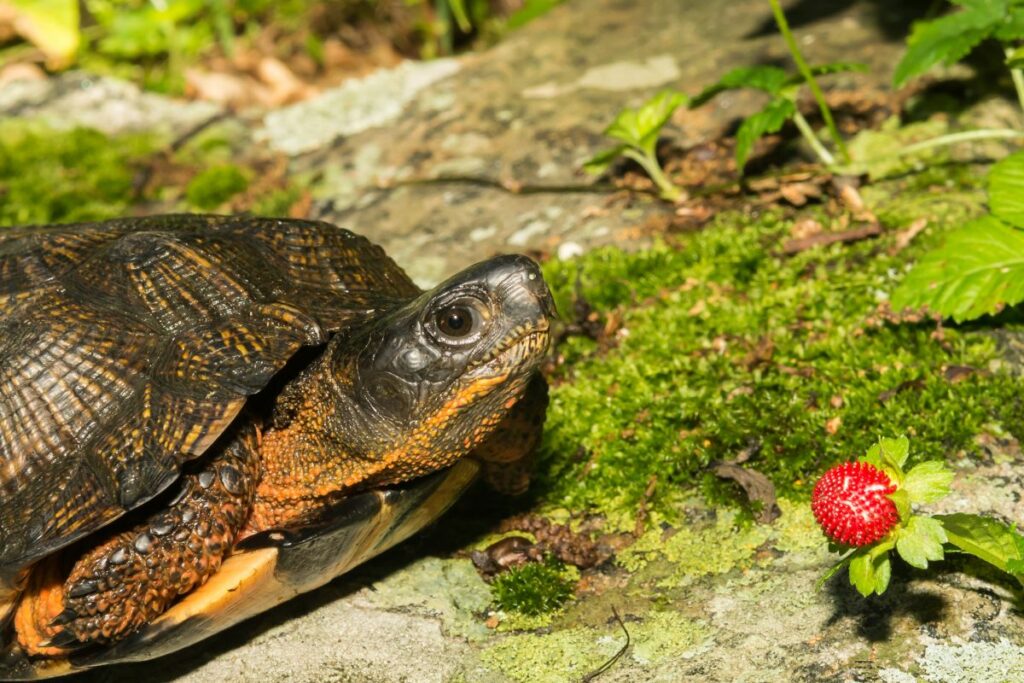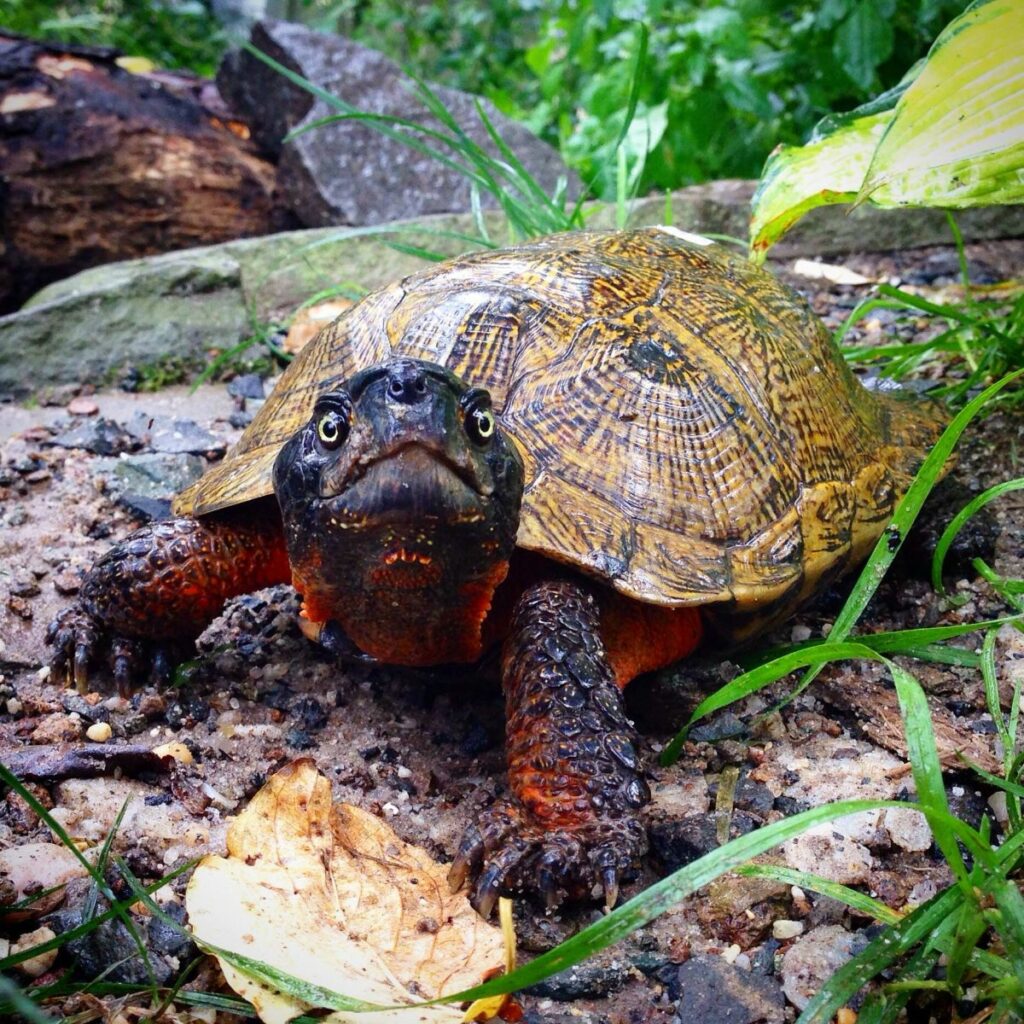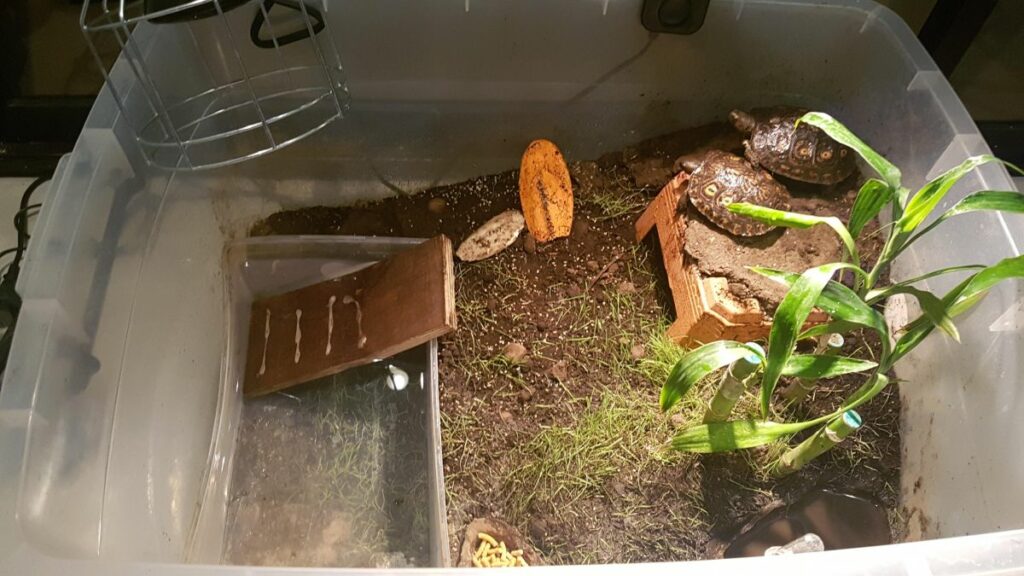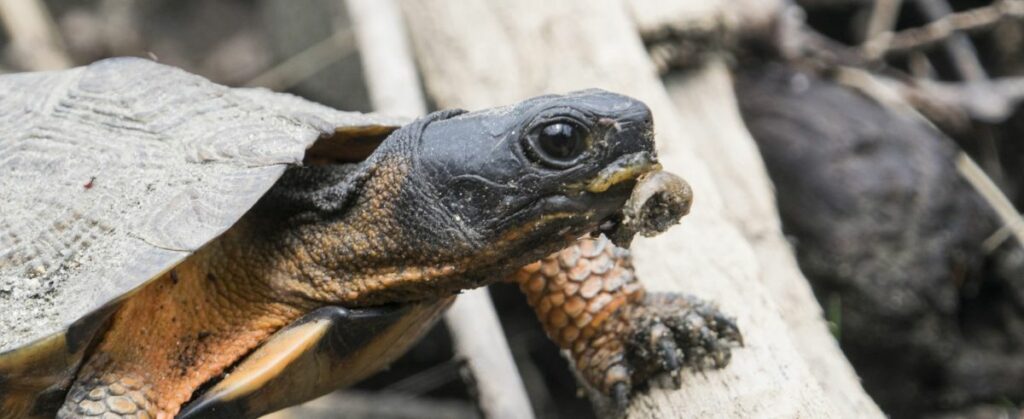People who own wood turtles vouch for their intelligence and personality. They are smart enough to trick worms into surfacing for an easy meal. They will scour their enclosure for any means of escape, and can climb tall fences.

In the wild, these endangered turtles prefer cool climates near rivers with moderate flow. They spend most of their lives in water, but also love digging through soil.
What Is A Common Wood Turtle?
A wood turtle shell (carapace) is more unique than other turtles because it’s chiseled and has a sculpture-like feeling to it. Their keeled carapace is dark brown to black with light yellow lines. The lines radiate from the center of each sloped, pyramid-like scute.
The lower portion of the shell (plastron) is yellow. Each scute has large, dark blotches at the corners.
The turtle’s skin is black and brown, but they have bright pigments of red, yellow, and orange.
Wood turtles have long tails with thick bases and their feet have slight webbing.
Wood Turtle VS Box Turtle
People often confuse wood turtles and box turtles because they have similar characteristics. But, a box turtle’s carapace is more dramatically doomed and the scutes are not pyramid-shaped. Plus, box turtles have a hinged plastron.
The other difference is that box turtles are weak swimmers. You will never see them diving underwater or walking along a river bottom like wood turtles do.
- Common Names: Wood Turtle
- Scientific Name: Glyptemys insculpta
- Origin: Northeastern United States
- Wood Turtle Size (Length): 5-9 in (12.7-22.9 cm)
- Wood Turtle Lifespan: 40-60 years
- Enclosure Size: 48 x 18 x 21 in (121.9×45.7×53.3 cm) +
- Temperament: Semi-aggressive toward other turtles, but interactive with caretakers
- Ease of Care: Moderate to difficult
Wood Turtle Range
Wood turtles live across the northeastern United States and parts of Canada. They live as far north as Nova Scotia and New England. The species lives southward into northern Virginia. Westward, they live through the Great Lakes region to Minnesota.
Wood Turtle Habitat

Wood turtles are semi-aquatic, living in and near rivers, streams, riparian forests near waterways, and wetlands. They also seem to like wooded floodplains with sparse openings for sunlight and lots of vegetation.
When they spend time on land, it is always within 1,000 ft (304.8 m) of a water source. They like water that has moderate flow and sandy or gravel substrate.
They prefer living in rivers or streams that have vegetation growing along the banks. Raspberry bushes, strawberries, willows, and grasses are all good for foraging.
Wood Turtle Behavior & Temperament
Like many semi-aquatic turtle species, wood turtles spend a lot of time crawling along the bottom of the river bed. They sift through the leaf litter and debris, looking for food.
These turtles are active on land and in water from late spring to early fall. Over the winter months, they prepare for hibernation. The temperatures drop in late autumn, so the turtles head to their preferred river or stream to select their hibernation spot.
They spend the entire winter underwater where they bury themselves in the riverbanks. Unlike some turtle species who bury themselves directly in the mud, wood turtles seek shelter in the exposed roots of partially submerged trees.
Turtles survive an entire winter underwater by taking dissolved oxygen from the water. As the water warms up, they become more active. Eventually, they emerge from the water completely, coming onto land to look for food.
What Do Wood Turtles Eat?
Wood turtles are omnivorous scavengers who eat just about anything that comes their way. Some of their favorite foods include worms, carrion, tadpoles, slugs, insects, fruits, leaves, moss, algae, and grass.
Wood turtles have even come up with a unique way to get their next meal. The Virginia Department of Wildlife Services describes their worm-collecting methods:
“Wood turtles perform a unique feeding behavior, in which they “stomp” the ground with their chest to attract worms to the surface. It’s believed that the worms react this way because the vibrations of the turtle’s movements mimic that of rain or the sound of a mole coming their way, a known predator of earthworms.”
Reproduction
Wood turtles have a long life span and don’t reach sexual maturity until about 11-12 years of age.
Female wood turtles lay their eggs in soft, sandy soil in late spring to early summer.
The mothers usually lay 4-12 eggs, which hatch in late summer or early fall. Some turtles may emerge right away, but most will overwinter in their nest. Either way, the baby turtles receive no care from their mother.
Female wood turtles can store sperm for many years before using it. When they are ready to lay eggs, they can use that stored sperm to produce fertilized eggs without needing to find a mate.
How To Care For A Wood Turtle
As an endangered species, it may be hard to find a breeder who sells wood turtles, but it’s not impossible. NEVER remove a wood turtle from the wild.
Enclosure

For a single adult wood turtle, your enclosure should be at least 48x18x21 in (121.9×45.7×53.3 cm), but going bigger is always better. For a group of four or more turtles, you’ll want something at least 20×30 ft (6×9 m).
If you have enough space, wood turtles do better housed outside during the warmer months. They are a very active species that loves lots of sunlight.
For outdoor enclosures, it’s best to build an overhang. Wood turtles are incredible climbers and can climb fences several feet tall.
Wood turtles are semi-aquatic, and most of their enclosure should comprise water. You’ll need a heavy-duty filter to provide your turtle with the cleanest water possible. Wood turtles are especially particular about the water quality in which they live. For best results, buy a filter handled to equip twice as much water as your enclosure holds.
Substrate
In the wild, wood turtles like sandy or gravel substrate because it’s easy for burrowing. To keep your turtles happy, you’ll want to replicate these substrates. Lots of sand, rich soil, and leaf litter will keep them healthiest.
If you’re keeping the turtles inside, provide them with a mixture of peat and topsoil that remains moist at all times.
Substrate isn’t necessary in the water portion of the enclosure, but it improves appearances.
Decorations
Give your turtle lots of live or artificial plants, driftwood, hollow logs, hollow rocks, or terracotta pots. These decorations give your turtle plenty of places to hide. If you buy hollow logs or rocks, make sure they’re large enough that your turtle can’t get stuck.
Temperature & Lighting
All turtles need exposure to UVB lighting for the health of their shells and bones.
If you’re keeping them in an outside enclosure, then they won’t need additional lighting as they’ll get UVB directly from the sun. Wood turtles don’t like exceptionally hot temperatures. So, avoid keeping them if you live in hot climates. Provide them with plenty of shade as well.
While your turtle is inside, give it a UVB bulb.
Place the UVB alongside a heat lamp to create a basking space. Keep the lamps about 12 in (30.5 cm) from the basking spot so they don’t burn your turtle. The basking temperature should sit between 85-90°F (29.4-32.2°C).
Ambient temperature should be between 75-80°F (23.9-26.7°C)
Keep the water temperature cooler, between 60-70°F (15.6-21.1°C).
Humidity
Wood turtles love humidity, so you should provide humidity between 80-90%.
Tank Mates
If you have a large enough enclosure, you can keep multiple wood turtles together. If you keep multiples, make sure that you only have a single male.
Diet

Wood turtles are omnivores. Turtles under six months of age should have a diet of half protein and half vegetables. They should receive a mix of each every single day.
Turtles between the ages of 6 and 12 months should receive a diet of half protein and half vegetables as well. But, they should only receive protein every other day while receiving vegetables every day.
Turtles older than a year should receive more vegetables than protein. 75% of their diet should comprise vegetables they receive every day. 25% of their diet should comprise protein two or three days a week.
Good protein options include commercial turtle pellets, crickets, earthworms, dubia roaches, bloodworms, silkworms, snails, or freeze-dried shrimp.
Healthy vegetables include dandelions, collard greens, green or red leaf lettuce, kale, carrots, raw grated squash, green beans, raw grated sweet potato, duckweed, water lettuce, and algae wafers.
You should also dust your turtle’s food in calcium every day.
Conclusion
Wood turtles face danger from habitat destruction and because of people taking wild turtles to keep as pets.
Wood turtles make wonderful pets because they’re interactive with their owners, and many people even claim to train them. They are active and entertaining to watch, but they require a lot of care.
In the wild, they use their intelligence to lure worms from the ground. Hopefully, we can protect this unique and intelligent species before it’s too late.
FAQs
Wood turtles are semi-aquatic. They spend most of their time in water, but spend some time on land as well.
Wood turtles were assessed by the International Union for the Conservation of Nature (IUCN) in 2010. The IUCN Red List lists wood turtles as “endangered” with a decreasing population.
Primary threats to these turtles include habitat destruction because of housing and agricultural development. Mining, roadways, railroads, recreational activities, logging, and fires and fire suppression cause problems as well.
Another major issue is hunting and trapping of these turtles. It is too common for people to take wood turtles from the wild to keep as their pets. This practice is illegal and harms the wood turtle population.
Mating varies between turtle species, but the result is much the same. The act requires cooperation because of the difficulty their shells present. The two turtles entwine their tails together, place their vents together, and the male inserts his penis.
Britannica describes turtle courtship as a range from “a seemingly abusive interaction to a titillation routine that entices the female’s cooperation.”
For instance, many male tortoises bite the female, immobilizing her so that she must mate. In contrast, sliders and cooters swim in front of the female they are trying to entice. They vibrate their front feet against her head in a kind of mating ritual. If she accepts, then mating occurs.
Studies show that turtles may be exceptionally intelligent, especially tortoises. Even Charles Darwin thought they must have exceptional memories because they travel long distances between where they eat, sleep, and bathe. Other explorers discovered they could train tortoises.
Despite Darwin’s observations, many people thought turtles were stupid because it’s easy to collect them.
The Okinawa Institute of Science and Technology says that there is more evidence today than ever for tortoises’ intelligence. Dr. Tamar Gutnick has spent nearly a decade working with and observing giant tortoises.
Dr. Gutnick and her colleague, Dr. Michael Kuba trained six groups of tortoises. The researchers used positive reinforcement and gave them three tasks to learn, each one more difficult than the last.
The tortoises learned all three tasks easily, so the researchers took it a step further. They waited three months before asking the tortoises to perform the tasks again. Every tortoise immediately remembered the first and second task. The third was a bit more complicated, but with a little extra training, they relearned it.
Besides tortoises, turtles are highly intelligent creatures. They have survived for over 250 million years, so they must be doing something right. One study shows that turtles have better hearing, smell, and sight than they did millions of years ago.
Although turtles are not as intelligent as mammals, they learn through instinct and experience.
